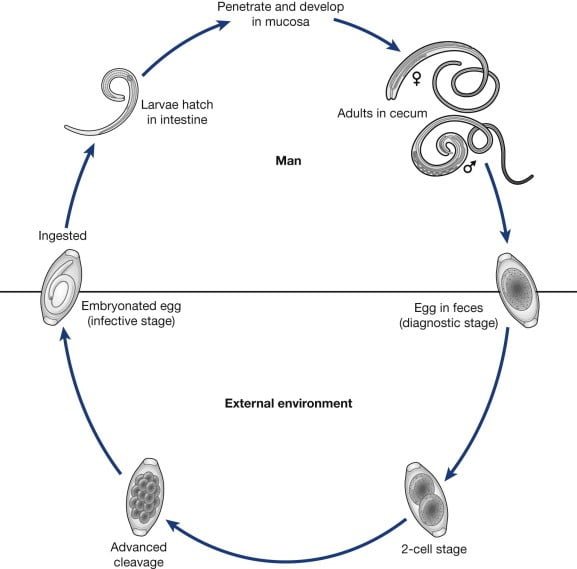Author : Roshni NepalTrichuriasis
Phylum – Nemathelmithes
Class – Nematoda
Genus – Trichuris
Species – T. trichiura
The nematode Trichuris trichiura, also called the human whipworm. The infective form for trichuriasis is the embryonated egg, which is ingested through soil-contaminated hands, food or water. They are also called as Soil- Transmitted Helmiths (STH). Infection often occurs in areas where human feces is used as fertilizer or where defecation onto soil happens.
Habitat and geographical distribution
Whipworms live in the large intestine. Worldwide, infection occurs more frequently in areas with tropical weather and poor sanitation practices, and among children. In 2002, the estimated number of persons infected with whipworm was 1 billion.
Life cycle of T. trichiura
The unembryonated eggs are passed with the stool. In the soil, the eggs develop into a 2-cell stage, an advanced cleavage stage, and then they embryonate; eggs become infective in 15 to 30 days. After ingestion (soil-contaminated hands or food), the eggs hatch in the small intestine, and release larvae that mature and establish themselves as adults in the colon. The adult worms (approximately 4 cm in length) live in the cecum and ascending colon. The adult worms are fixed in that location, with the anterior portions threaded into the mucosa. The females begin to oviposit (lay egg) 60 to 70 days after infection. Female worms in the cecum shed between 3,000 and 20,000 eggs per day. The life span of the adults is about 1 year. Life cycle continues with passing of these eggs in soil.

Fig – Life cycle of T. trichiura
Clinical manifestation of trichuriasis
People infected with whipworm can suffer light or heavy infections. People with light infections usually have no symptoms.
People with heavy symptoms can experience frequent, painful passage of stool that contains a mixture of mucus, water, and blood. Rectal prolapse can also occur. Heavy infection in children can lead to severe anemia, growth retardation, and impaired cognitive (thought) development.
Laboratory diagnosis
The standard method for diagnosing the presence of whipworm is by microscopically identifying whipworm eggs in a stool sample. Because eggs may be difficult to find in light infections, a concentration procedure is used.
Proctoscopy – shows worm in rectal mucosa.
Treatment, prevention and control
- albendazole and mebendazole, are the drugs of choice for treatment
- Iron supplements may also be prescribed if the infected person suffers from anemia.
- Avoid ingesting soil that may be contaminated with human feces, including where human fecal matter or wastewater is used to fertilize crops.
- Wash your hands with soap and warm water before handling food.
- Teach children the importance of washing hands to prevent infection.
- Wash, peel, or cook all raw vegetables and fruits before eating, particularly those that have been grown in soil that has been fertilized with manure.